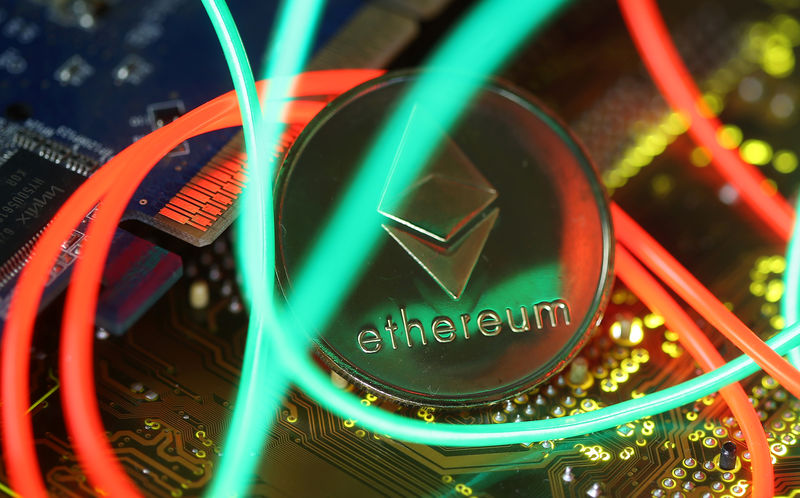By Tom Wilson
LONDON (Reuters) - Some are backed by dollars. Others by gold. But this "stablecoin" isn't tied to any major asset - it's backed by another cryptocurrency.
Stablecoins, such as Facebook's (O:FB) Libra, are a new breed of cryptocurrencies that aim to escape the wild price swings that make bitcoin unworkable for commerce. They base their value on more stable underlying assets, typically traditional currencies or commodities.
But Dai, in a major divergence from others, uses a volatile digital currency - ethereum - to maintain a steady value.
This might appear to defy common sense, but its advocates say the way it works - with "smart contracts," blockchain-based covenants with terms set in code - means Dai will always keep a stable value while offering transparency.
Stablecoins like Libra and Tether are in global regulators' sights, partly because of concerns over how the companies behind them manage the reserves that back them.
Dai, launched in 2017, seeks to dodge such concerns by giving up control of the ethereum coins its value is tied to, locking them instead in the blockchain contracts run by algorithms. That, supporters say, offers the benefits of stablecoins - instant transactions and steady value - while avoiding governance risks.
It is gaining some traction: the Oxfam aid agency is testing it for distributing aid on a Pacific island, while some Argentinian savers desperate to avoid inflation are using it.
How regulators treat Dai could help shape how, and if, cryptocurrencies can evolve from speculative use to a de facto money of the internet. But their response is still unclear.
Reuters is tracking the emergence of contenders to bitcoin - the "altcoins" - as they attract increasing attention from investors, regulators, companies and individuals.
The fourth in the series looks at Dai.
HOW DOES IT WORK?
Like bitcoin, Dai hopes to power a digital economy where people can bypass banks and other financial firms to transact directly with one another. Its workings are complex.
Dai is effectively pegged to the dollar, and backed by ethereum cryptocurrency locked in publicly viewable contracts that are stored on the blockchain.
Many stablecoins are trusted because their value is underpinned by central bank currencies. Users trust Dai, on the other hand, as the ethereum that is locked in the contracts always exceeds the value of Dai in circulation.
When Dai's value strays too far from the dollar, balancing mechanisms kick in to guide it back.
"With a decentralized stablecoin, you can see everything on the blockchain," said Rune Christensen, founder of the protocol that Dai runs on, MakerDAO. "Anyone can go and do a real-time audit."
Click here https://fingfx.thomsonreuters.com/gfx/editorcharts/CRYPTO-CURRENCIES-ALTCOINS-DAI/0H001QXHS9CC/index.htmlfor an interactive version of this graphic.
WHO'S IN CONTROL, THEN?
Dai is not yet entirely decentralized.
The Cayman Islands-registered Maker Foundation, run from Copenhagen, oversees the technology.
The foundation, also headed by Christensen, develops code and other projects it hopes will allow Dai and MakerDAO to be entirely controlled by its users.
Mariano Conti, head of smart contracts, said he hoped the foundation could cease to exist within two to three years.
"The purpose is to bootstrap the system until it's no longer needed," said Conti, who is based in Buenos Aires.
But risks exist in the governance model.
Flaws in smart contracts, for instance, could leave it vulnerable to exploitation and the theft of assets stored on the blockchain, said Timothy Stranex, co-founder of Luno, a crypto exchange in London.
MakerDAO says an "emergency shutdown" mechanism guards against attacks. Should users seek to take over the protocol, it says, the shutdown would be triggered to protect collateral and return funds.
Click here https://fingfx.thomsonreuters.com/gfx/editorcharts/CRYPTO-CURRENCIES-ALTCOINS-DAI/0H001QXHV9CJ/index.htmlfor an interactive version of this graphic.
HOW DO REGULATORS SEE IT?
It's unclear.
Cryptocurrency-backed stablecoins fell outside the scope of a G7 report https://www.bis.org/cpmi/publ/d187.pdf last month that said their ability to keep a steady value in the medium term was questionable.
U.S. regulators declined to comment on Dai.
Britain's Financial Conduct Authority said it did not use the term "stablecoin," given stability was purely an aspiration, and that a thorough case-by-case analysis was needed.
Stablecoins like Dai present a new front for regulators as they strive to tame the fast-moving world of cryptocurrencies, experts said.
"The regulators are trying to fit the existing framework onto these new technologies," said Phil Angeloff, a lawyer at Clifford Chance in Washington who has worked on stablecoins.
Click here https://fingfx.thomsonreuters.com/gfx/editorcharts/CRYPTO-CURRENCIES-ALTCOINS-DAI/0H001QXHW9CP/eikon.png for an interactive version of this graphic.
HOW'S IT FARED IN THE REAL WORLD?
Better than many cryptocurrencies used mainly for speculation.
Oxfam has tested Dai this year for distributing aid in the Pacific island state of Vanuatu, prone to natural disasters. It gave Dai to around 200 people and 30 vendors on one of Vanuatu's 80-plus islands, building a mini Dai-based economy.
"It allows us to control more, and interact economically more directly with each other - and more quickly - after a disaster," said Oxfam's Sandra Hart, speaking from Vanuatu's capital Port Vila.
Another larger version of the trial is planned in Vanuatu next year, Hart said, spread across multiple islands.
Dai is also attracting attention in inflation-hit Argentina.
Data is scarce, but a Telegram messaging group for Dai users in the country has doubled in size to over 450 members in recent weeks, the Maker Foundation's Conti said.
Reuters spoke to five users in cities across the country, who said Dai offered a chance to protect their savings against the peso's falling value.
"My mom and I started to save a part of our money in Dai," said Romina Sejas, a law student in the western city of Mendoza.
"We can't save our money in pesos. Every month we have inflation. We have to be creative to survive to the decisions of our politicians."
Dai's decentralisation made it an attractive alternative to other stablecoins, said Jose Villar, a software program manager in Buenos Aires.
"All others, there is some entity behind that can be a bank, and we don't know who is really behind them."
